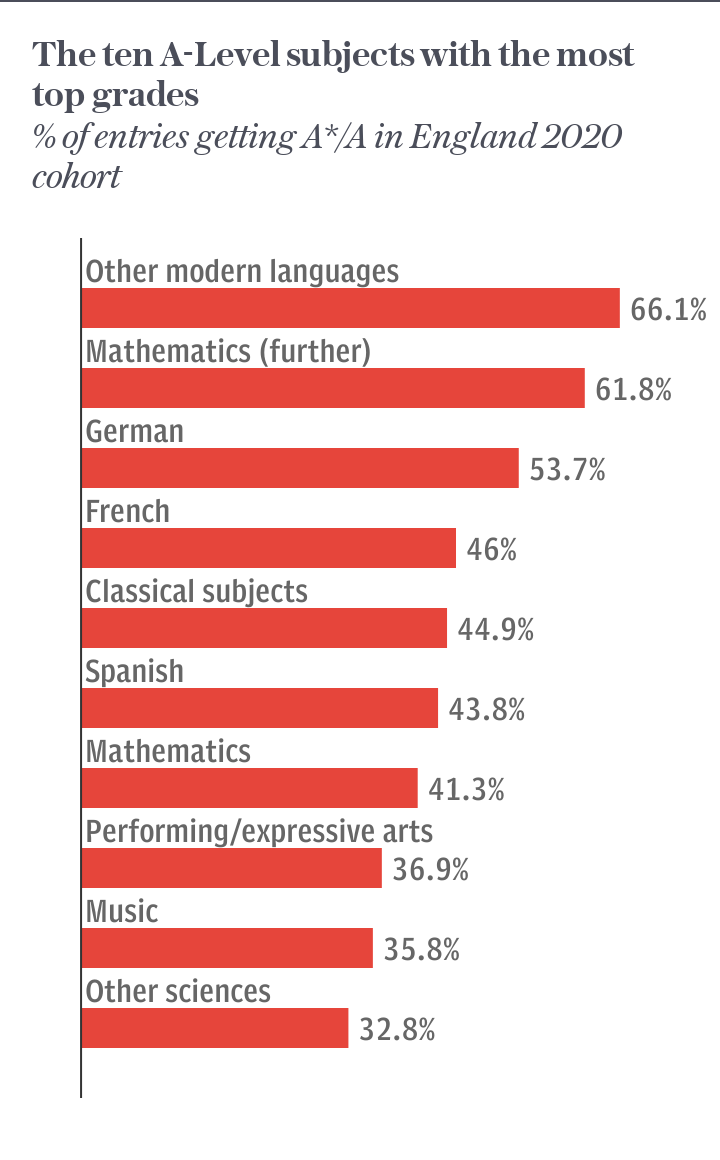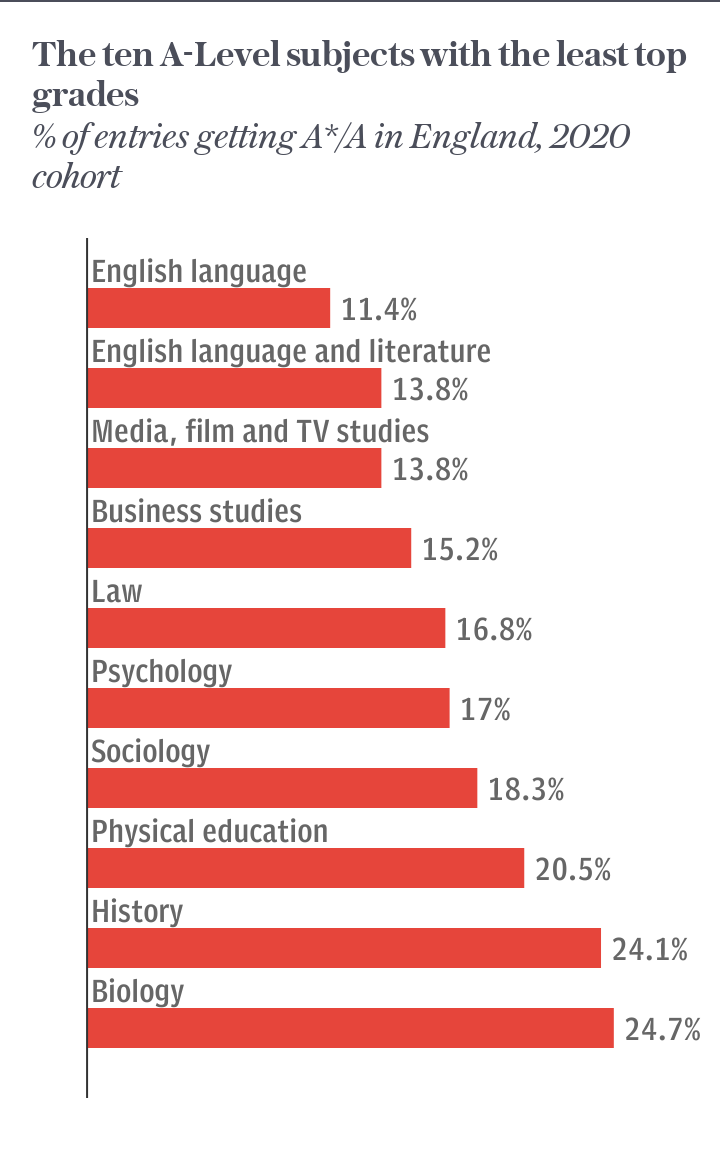Almost 40 per cent of A-level results downgraded as Government under pressure to U-turn

Close to 40 per cent of A-level grades were downgraded, figures show, amid calls for the Government to U-turn on its grading system.
A total of 39.1 per cent of grades in England were lowered from teachers’ predictions, data from the exam regulator Ofqual showed. The graph below shows the breakdown.
The majority of grades (35.6 per cent) were lowered by one grade, while 3.3 per cent were pulled down by two grades and 0.2 per cent were bought down by three grades.
This year 27.6 per cent of A-levels were graded as A or A*, which is a 2.4 increase on last year and is the highest proportion of top grades since 2001.

But, as pupils around the country received their A-level results, the Government faced growing calls for it to abandon its grading system which was largely based on using a statistical model as well as a rank order drawn up by teachers.
Geoff Barton, General Secretary of the Association of School and College Leaders, said that while there has been an overall increase in top grades, headteachers are “very concerned that this disguises a great deal of volatility among the results at school and student level”.
He went on: “We have received heartbreaking feedback from school leaders about grades being pulled down in a way that they feel to be utterly unfair and unfathomable. They are extremely concerned about the detrimental impact on their students.
“We are now calling on the government and the exam regulator Ofqual to review the situation as a matter of urgency, and we would warn them against simply digging in their heels, and insisting all is well.
The Sixth Form Colleges Association said: “The process for calculating this year's A-level results appears to have fundamentally failed, based on our survey of sixth form colleges”
The association said that the Government and Ofqual “must now revert to teacher-assessed grades”.
Read more: A-level results day 2020 - live updates
Grades calculated by statistical model
This year’s grades have been calculated by a statistical model - which took into account various factors including pupils' past performance as well as their school’s historic grades – combined with the rank order drawn up by teachers.
The Office of Qualifications and Examinations Regulation (Ofqual) came up with model to calculate grades and teachers were asked to put students in a rank order of best to worst.
Earlier this week, the education secretary apologised for the disruption students have faced but refused to back down over the use of an algorithm to calculate A-level results.
Gavin Williamson said that if teachers’ predictions were awarded to pupils unaltered, grades would “shoot up” and the qualifications would be “devalued”.
On Wednesday evening he made an eleventh hour change to the system which meant that pupils can now appeal against their grade on the basis of their mock exam results.
It was the latest in a series of last minute changes to the appeals system ahead of results day and followed a major U-turn by the Scottish Government which threw Whitehall into a panic about how to head off a similar crisis.
John Swinney, the education minister, announced on Tuesday that the 124,564 grades that had been downgraded by their algorithm would be withdrawn and replaced with teachers’ recommendations.
The Welsh education minister Kirsty Williams pledged to introduce a “safety net” whereby students would not get a lower A-level grade than their AS mark.
Unlike in England, where AS levels were axed under a series of reforms to “toughen up” A-levels, they remain in place in Wales meaning they can be relied on as an indicator of a pupil’s performance in exam conditions.
Read more: A-level results day guide to clearing, grades and next steps
Williamson vows: no more changes to grading
Mr Williamson gave his assurance on Thursday that he will not make the same exams grade U-turn as was seen in Scotland.
"What is clear to me is there will be some youngsters, no matter how much we try to do in terms of this system to maximise the fairness of it, who don't get the grade they should have potentially have got," he said.
"That's why we need to have a really robust system, that's why we've got the triple lock."
Mr Williamson said this would provide "robust grounds of appeal" and allow pupils to take exams later in the year if required.
But despite claims that Ofqual has no system in place for assessing the validity of mock exam results, the Education Secretary said there was "a whole range of routes that schools can take the appeal process through", adding that "the mock exam was an important step forward to ensure there's enhanced fairness for all pupils right across England".
He said more information about appeals would be released to schools and colleges "over the next few days".
Languages and mathematics students excel while English languishes
Languages and mathematics saw the highest proportion receiving the top grades amid a fall in the total number of entries sitting.
Two thirds (66.1 per cent) of those sitting modern languages other than French, Spanish and German received either A* or A, up 15 percentage points on last year.

For further mathematics it was 61.8 per cent, up 8.3 percentage points on last year.
Some of the subjects receiving lowest proportion of the coveted top grades were English language (11.4 per cent), media, film and TV studies (13.8 per cent) and business studies (15.2 per cent).

The sciences continue to be most popular among girls
The 2019 A-Level cohort saw the proportion of entries among girls sitting the three main science subjects - biology, chemistry and physics - overtake boys for the first time since 2011.
That trend has continued, with the gap between the genders widening in 2020.
The proportion of entries into the sciences among girls rose from 50.3 per cent in 2019 to 50.9 per cent in 2020.
But overall entries into sciences mirror the wider trend, with falling numbers of entries across the board.
Around 10,000 fewer entries were made among girls in 2020 across the sciences among girls from the previous year, and 11,000 fewer entries among boys.
More girls are sitting biology (38,067 entries among girls vs 21,406 among boys) and chemistry (28,120 vs 23,730 boys), but more boys are still sitting exams in physics (7,997 girls vs 26,999 boys).
But girls achieved higher than boys in physics, with 33.7 per cent achieving A* and A, versus 29.8 per cent among boys.
Girls also performed better in biology (25.3 per cent achieving the top grades vs 23.7 per cent for boys), but boys did best in chemistry (32.1 per cent for boys vs 28.9 per cent for girls).
Overall, girls made up 55.4 per cent of all A-Level entries in 2020, up from 55 per cent in 2019 and 2018.
It has been the best year for attainment among both boys and girls, with the former achieving 27.1 per cent A* and A (up 1.9pp on 25.2 per cent in 2019) and the latter achieving 28 per cent A and A* (up 2.9pp from 25.1 per cent in 2019).


 Yahoo News
Yahoo News 
